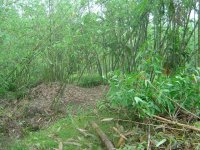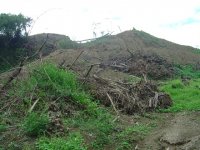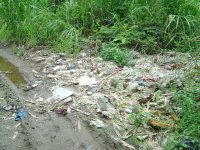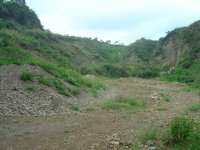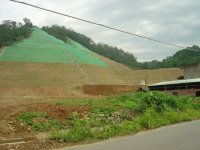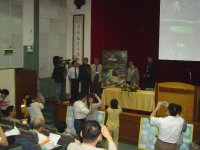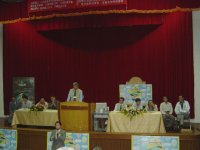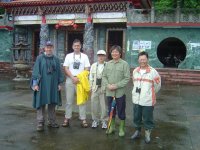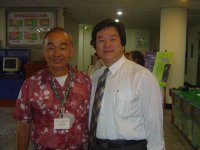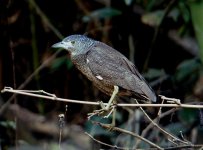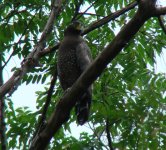Mark Bruce
Super Moderator
Poor Huben
Nothing gets the blood boiling like watching your local patch being abused.I spent last weekend with Christina MacFarquhar from the Taipei based, Wild at Heart Legal Defense Association going around Huben.Wild at Heart is spearheading the legal battle to stop the Hushan Dam project.Apart from doing a fair amount of actual birding, we also looked at issues other than the Hushan Dam that are impacting very negatively on the Huben / Hushan area.
We started early on Saturday afternoon meeting up with well known Taiwanese ornithologist "Scott" Lin Ruey-Shing of the Taiwan Endemic Species Research Institute.Christina had a stack of questions for Scott to answer on the Fairy Pitta and the ecology of the area.This was followed by going out into the field to find a Pitta.Well, birding is always unpredictable and in spite having the top Pitta Man in the country leading us, the Pitta weren't showing themselves.At one point we had a Pitta calling in the canopy directly above us, but we couldn't locate him in the thick foliage.
The following morning was spent with Christina and I trying to see a Pitta.Again we had one calling directly above us but failed to locate it.After a few hours of birding we looked at some areas which had be gravel mined a few years before.Gravel mining is Big Business in Taiwan and a major cause of habitat loss.The sad thing about these former gravel mines is that no rehabilitation of the area has taken place in most instances and when there has been some rehabilitation it appears to be only window dressing.
The area is still very much under pressure from both legal and illegal deforestation and gravel mining.Fortunately, Legislator Yin Ling-ying is from the area and she has done a lot to halt gravel mining.
Last year in August the area was hit quite badly by a typhoon.The typhoon caused quite a bit of damage to areas of bamboo but no clean up followed.Suddenly,the week the Pitta arrived they've started cleaning up the broken bamboo.Why this project needed to get underway at the start of the breeding season is beyond me.Again,it's just another unnecessary hardship the Pitta and many other species have to endure.
Illegal dumping also is a problem.But possibly the most distasteful problem the Pitta has to face is unscrupulous birders and photographers.A number of photographers, often clad in Birdlife and other birding NGO clothing, clamber down into the stream beds to stakeout nests for an easy shot.
After spending most of the morning in the field we met up with Scott Lin and Mr.Chang at the Fairy Pitta Information Centre for lunch.After lunch Christina and I spent the afternoon going over more gravel mines and part of the Hushan Dam project site before she headed back to Taipei.
Nothing gets the blood boiling like watching your local patch being abused.I spent last weekend with Christina MacFarquhar from the Taipei based, Wild at Heart Legal Defense Association going around Huben.Wild at Heart is spearheading the legal battle to stop the Hushan Dam project.Apart from doing a fair amount of actual birding, we also looked at issues other than the Hushan Dam that are impacting very negatively on the Huben / Hushan area.
We started early on Saturday afternoon meeting up with well known Taiwanese ornithologist "Scott" Lin Ruey-Shing of the Taiwan Endemic Species Research Institute.Christina had a stack of questions for Scott to answer on the Fairy Pitta and the ecology of the area.This was followed by going out into the field to find a Pitta.Well, birding is always unpredictable and in spite having the top Pitta Man in the country leading us, the Pitta weren't showing themselves.At one point we had a Pitta calling in the canopy directly above us, but we couldn't locate him in the thick foliage.
The following morning was spent with Christina and I trying to see a Pitta.Again we had one calling directly above us but failed to locate it.After a few hours of birding we looked at some areas which had be gravel mined a few years before.Gravel mining is Big Business in Taiwan and a major cause of habitat loss.The sad thing about these former gravel mines is that no rehabilitation of the area has taken place in most instances and when there has been some rehabilitation it appears to be only window dressing.
The area is still very much under pressure from both legal and illegal deforestation and gravel mining.Fortunately, Legislator Yin Ling-ying is from the area and she has done a lot to halt gravel mining.
Last year in August the area was hit quite badly by a typhoon.The typhoon caused quite a bit of damage to areas of bamboo but no clean up followed.Suddenly,the week the Pitta arrived they've started cleaning up the broken bamboo.Why this project needed to get underway at the start of the breeding season is beyond me.Again,it's just another unnecessary hardship the Pitta and many other species have to endure.
Illegal dumping also is a problem.But possibly the most distasteful problem the Pitta has to face is unscrupulous birders and photographers.A number of photographers, often clad in Birdlife and other birding NGO clothing, clamber down into the stream beds to stakeout nests for an easy shot.
After spending most of the morning in the field we met up with Scott Lin and Mr.Chang at the Fairy Pitta Information Centre for lunch.After lunch Christina and I spent the afternoon going over more gravel mines and part of the Hushan Dam project site before she headed back to Taipei.
Attachments
Last edited:




